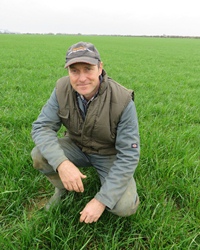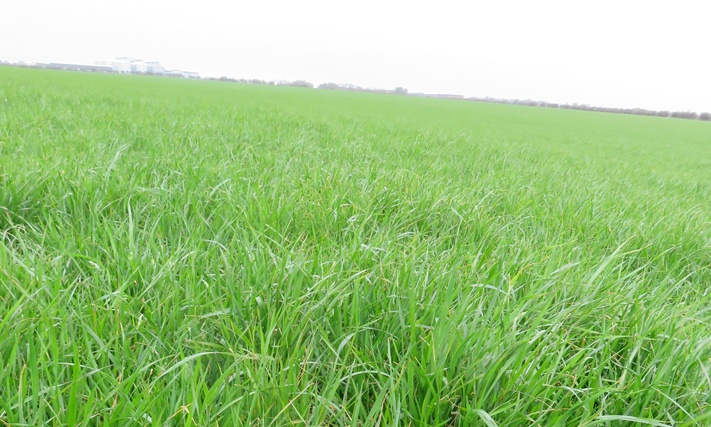Boost silage quantity and quality with short-term leys
Two-year leys are producing tonnes of conserved forage of high nutritional value and helping reduce feed costs on one Lincolnshire estate
There are not many dairy herds left north of Lincoln, but the Spitalwood herd of 400 pedigree Holsteins remains resolute, milked three times a day and yielding 10,500 litres of milk per cow a year.
This 612ha traditional mixed farming estate at Spital in the Street, grows potatoes, wheat, barley and maize, with silage leys acting as a two-year break crop. Parkland is used for dry cow and heifer grazing.
The fields straddle the busy A15 south of Market Rasen, an area known as the Lincoln Cliff. The soils range from heavy clay loam to lighter, free-draining but stony limestone brash. With 685mm of annual rainfall, drought can be a problem in summer.
The herd calves all year round and is fed a TMR from a Keenan mixer wagon. Grass and maize silage are fed in a 50:50 mix with a range of straights. The forage comes from 70ha of maize and 70ha of silage leys.
“Grass is an integral part of the arable rotation, and has a job to do clearing up blackgrass and improving soil structure,” explains farm manager James Brook. “But more importantly it has to provide large amounts of high quality forage for the dairy cows.
 James Brook
James Brook
“With the current low milk price, it is now more critical than ever to reduce our costs of production. Having a lot of high quality silage allows the amount of straights and concentrate feeds offered in the parlour to be cut to save money.”
Special mixture
For the past two years, Mr. Brook has sown a special mixture of one third each of Fox Italian ryegrass, Itarzi tetraploid Italian ryegrass and Perseus – a meadow fescue x Italian ryegrass festulolium. Each has been chosen for its bulky, leafy growth, and deep-rooting Perseus also performs well in dry summers.
One field, which was drilled after an early wheat harvest on 17 August 2014, went on to produce 58t/ha of fresh weight material (20.2t/ha DM) in 2015, and retained high quality throughout the season.
Silage quality from first, second and third cuts of a new silage ley.
| 1st Cut | 2nd Cut | 3rd Cut | |
| Dry Matter (%) | 35.5 | 38.1 | 31 |
| Crude Protein (%) | 14.2 | 13.3 | 16 |
| D Value | 76 | 69 | 69 |
| ME (MJ/kg) | 12.2 | 11.1 | 11.1 |
The new grass established quickly and farmyard manure was applied in the autumn. Two hundred and fifty ewe lambs were brought-in in November for five weeks, to graze it down to encourage the new plants to tiller and spread.
On 10 March 69kg of nitrogen (N) fertiliser were applied, topped up with 45kg on 24 March. On 17 April the field was sprayed with a propiconazole fungicide to prevent rust and mildew attack.
The first cut of 21t/ha was taken on 14 May with a mower conditioner, cutting at a height of 100mm to avoid picking up stones. The grass was dispersed using the spread hood on the mower and left to wilt for 24 hours. It was then promptly raked in with a 10m rake and picked up with a forage wagon.
The next day 100kg N/ha was applied and the second cut was taken on 17 June, yielding 16.5t/ha. A further 75kg N/ha was applied to the aftermath, with the third cut of 8.5t/ha taken on 23 July.
A final application of 50kg N/ha was applied and the final cut was taken on 30 August, giving 12t/ha.
 Bulky growth of a second year silage ley. This field yielded 58t-ha fresh weight last year.
Bulky growth of a second year silage ley. This field yielded 58t-ha fresh weight last year.
“Our dairy team is very pleased with how well the cows are milking on this silage; in particular the consistency of quality across the cuts,” says Mr. Brook.
“We treat silage like we do arable crops. We apply inputs using tramlines, so there is no trafficking compaction across the field.
“Last year was also a fantastic grass-growing year and it rained at the right time. Cutting higher and using a better and bigger rake, together with tremendous commitment from our farm staff to get the job done in the best conditions, have also contributed to the quality.”
Short-term trends
Rod Bonshor, general manager for Oliver Seeds, has noticed a move towards two to three year mixtures for cutting leys, with farmers looking to grow as much home-grown forage as possible.
“When the milk price is rocking along the bottom, farmers are asking themselves, what can I grow to feed the cows rather than buying in,” says Mr. Bonshor.
“They can achieve large potential yields from sowing short-lived species. Long term leys stay down a lot longer, but will yield just 8 to 10t/ha/cut fresh weight, not 20t/ha.”
While Italian ryegrass is the traditional silage species, newer hybrid ryegrasses, crosses between Perennials and Italians, can be more adaptable and will not produce a seed head as quickly. Although not potentially as high yielding as Italian ryegrass in the first one to two years, they become leafier and not stemmy, the more they are cut. This increases leaf yield, enhancing forage quality and adding density and durability to the sward. Citeliac and Tetragraze are good examples of hybrid ryegrasses.
Festuloliums, crosses between perennial ryegrasses and fescues are also good for silage. As well as being deeper rooted, they also have larger, broader leaves, adding bulk to silage cuts. They are also far more tolerant of adverse climatic conditions.
“Farmers looking to cut their bought-in protein should also be considering adding red clover into their silage mixtures,” says Mr. Bonshor. “Red clovers sit well in short term leys and when paired with ryegrasses can sustain, and even enhance the yield of the sward in year two.”
This article first appeared in BRITISH DAIRYING April 2016
